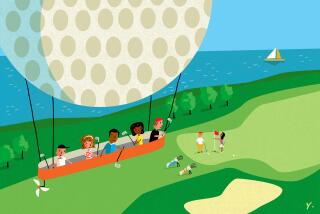Out of Step With ‘90s? Country Clubs Acknowledge They Have to Change : Lifestyles: Reducing fees, attracting the whole family and performing community service are ways some institutions try to stay current. Others remain white male bastions.
DULUTH, Ga. — It’s a sunny American dream of summertime.
The plink of tennis balls on high-tech rackets. The wheeze of carts as businessmen roll between deals and holes of golf. The chlorine-reddened eyes of swim team members, leaning for the starter’s gun.
Through the 1950s, ‘60s and ‘70s, the ideals and caricatures of the country club blossomed with suburbia. In the ‘80s, new wealth brought new clubs, many sprouting skirts of million-dollar homes.
But what about the ‘90s, the decade claiming the mantle of frugality and egalitarianism? Have clouds blocked the sunny dream? Have country clubs outlived their day?
The answer is neither yes nor no.
More than a third of club managers in a 1991 survey said their main problem was declining membership, and the National Golf Foundation recorded a 6.7% decline in private golf facilities from 1987 to 1992, during a time when public courses increased and the number of golfers rose from 21.2 million to 24.8 million.
Still, many managers--and members--say their clubs are alive and adapting.
They recognize they have to change from white male bastions to embrace busy, distracted baby boomers and their families, they say. And while country clubs remain exclusionary by definition, today they strive to present themselves as not being out of touch.
At St. Ives Country Club in this suburban town, where a dozen clubs line a 10-mile stretch known as “country club alley,” typical houses along manicured fairways sell for $500,000 or more. But manager Bill Langley emphasizes community spirit and charitable activities.
Many members are people transferred to nearby Atlanta by their companies, and the club gives them a quick way to plug in socially. “This gives them a sense of family, of community,” Langley said, noting that membership is growing at the club, where initiation fees start at $22,000.
Stan Davis, 47, a St. Ives member waiting in a golf cart for the rest of his foursome, summarized the changes he’s seen. In the free-spending ‘80s, when recreation meant travel, “we wanted to go to exotic places,” he said. Nowadays, Davis said, “You’re seeing people turning in.”
The response from clubs? “They’ve become more family-oriented. Before, country clubs were pretty much exclusive to the men,” he said.
Kathi Driggs, vice president of the Alexandria, Va.-based Club Managers Assn. of America, agrees.
Country clubs realize they have to do a better job of marketing a ‘90s ideal of family-centered recreational value, as they distance themselves from the image presented by headline-grabbing clubs that still restrict membership on the basis of race or sex, she said.
Club managers say they are gradually remaking their facilities. Besides offering more attractions for children, many are changing fee structures to allow for more reduced-rate “junior memberships” to attract younger people.
Waiting lists are shorter at many clubs than they were 10 or 15 years ago, which may indicate that interest is less intense among baby boomers, Driggs acknowledged.
At the same time, the age of members is going down. In 1991, about 44% of members were in the 35-54 age group, compared to 30% just two years earlier, according to a survey by the club managers’ group. “And people are using their membership more frequently,” Driggs said.
The survey found that the average country club had gross annual revenues of $2.58 million, and that initiation fees varied widely.
“I’m on the installment plan,” said Phil Arnold, who is paying off his fee at a country club in Cary, N.C., over time. The average fee for a regular membership nationally is around $13,650; Arnold’s is $10,000.
“I don’t think that’s contradictory to a frugal, more restrained lifestyle,” he said.
Arnold, an avid golfer who is executive vice president of the Golf Course Builders Assn., noted his club’s unrestricted membership and lack of a haughty attitude make it “a model for anyone.”
It’s unclear how many of the estimated 7,000-plus golf and country clubs in the United States have restricted memberships. About 3% of the 3,000 clubs affiliated with the Club Managers Assn. of America are restricted, Driggs said.
In a case that industry officials call a watershed, Shoal Creek Country Club near Birmingham, Ala., became a focus of controversy when black officials questioned plans to hold the 1990 PGA Championship there. When a black member was hastily admitted, critics charged tokenism.
The furor prompted the Professional Golfers Assn., PGA of America and the United States Golf Assn. to require clubs hosting tournaments to have open membership policies.
“There has been progress,” said John F. Merchant, a black Connecticut lawyer now serving on USGA’s executive committee. But he called country clubs “the last piece of the puzzle” for minorities. Before club membership is possible, economic opportunity must be expanded, he said.
“There’s a lot of things that are attacking the good old boy kind of attitude,” said Catherine Suddarth of the National Golf Foundation in Jupiter, Fla., noting that public-facilities legislation has outlawed discrimination in membership if a club is used for business.
A study by the foundation found that in 1991, about 64% of all U.S. golf courses were open to the public.
“We’re moving toward upscale daily-fee facilities,” Suddarth said. “But I don’t think private clubs will ever be passe.”
If some folks at country clubs are sensitive about appearing out-of-step with an era claiming to be more inclusive and frugal, others say that the many clubs doing well in the ‘90s are merely responding to the times, to a mobile society often isolated in suburbia.
Under the antique slate roof of the $9.8-million St. Ives clubhouse, membership director Suzanne Carmichael said the richly paneled bar and grill room has, in effect, become a community center.
“We want to be something integral to the community,” she said. “We’re not trying to stand apart.”


